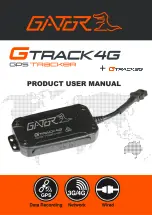
20
Test and Finish the Installation
T
EST AND
F
INISH THE
I
NSTALLATION
Once you have installed both the control head and the transducer, and have routed all the
cables, you must perform a final test before locking the transducer in place. Testing should
be performed with the boat in the water.
1
|
Confirm Sonar Signal on the Control Head
1. Power on the control head (see the section
Power On the Control Head
). If the unit does not power-up, confirm that the cable
connectors are properly connected and that power is available.
2.
Setup Guide:
See the section
Setup Guide
for initial start up instructions. You must complete the steps indicated in the Setup Guide
before starting normal operation.
NOTE
: After completing the Setup Guide, the control head will automatically enter normal operation.
3. Press the
HOME
key
.
4. Select a sonar view from the Favorites bar to display on-screen.
NOTE
: See your control head operations manual for more information about selecting views.
5. If the bottom is visible on-screen with a digital depth readout, the unit is working properly. Make sure that the boat is in water
greater than 2' but less than the depth capability of the unit, and that the transducer is fully submerged, since the sonar signal
cannot pass through air.
NOTE
: The transducer must be submerged in water for reliable transducer detection.
6. If the unit is working properly, gradually increase the boat speed to test high-speed performance. If the unit functions well at low
speeds, but begins to skip or miss the bottom at higher speeds, the transducer requires adjustment.
2
|
Make Adjustments
NOTE
: It is often necessary to make several incremental transducer adjustments before optimum high-speed performance is
achieved. Due to the wide variety of boat hulls, however, it is not always possible to obtain high speed depth readings.
NOTE
: The deeper the transducer is in the water, the more likely that a rooster tail of spray will be generated at high speeds, so
make sure that the transducer is as high as it can be and still be submerged in the water.
DualBeam PLUS Transducer
1. If you have the correct angle set on the transducer, yet lose a bottom reading at high speed, adjust the height and the running angle
in small increments to give you the ideal transducer position for your boat. First, adjust the height in small increments (see
DualBeam
PLUS Transom Mount Installation: Assemble the Transducer and Initial Mounting
).
If you are still not getting good high-speed readings, you may need to disassemble the transducer mounting assembly and
re-position the ratchets, using the illustrations showing the transducer knuckle positions in the section
DualBeam PLUS Transom
Mount Installation: Assemble the Transducer and Initial Mounting
. If you do change the transducer position, re-trace the position
of the mounting bracket before proceeding.
Side Imaging Transducer
1. If you have the correct angle set on the transducer, yet lose a bottom reading at high speed, adjust the transducer to a lower depth
in the water. If you reach the top of the screw slots and continue to lack high-speed performance, increase the angle of the
transducer by lowering the back of the transducer in increments of 1/8".
Test the Installation
Summary of Contents for ONIX10
Page 4: ......
















































